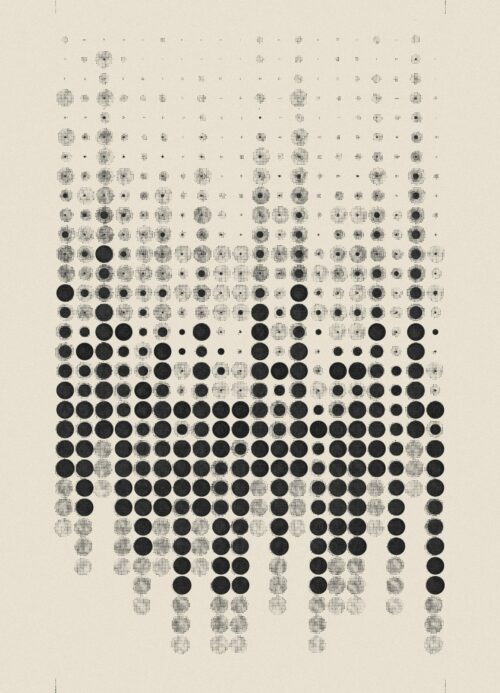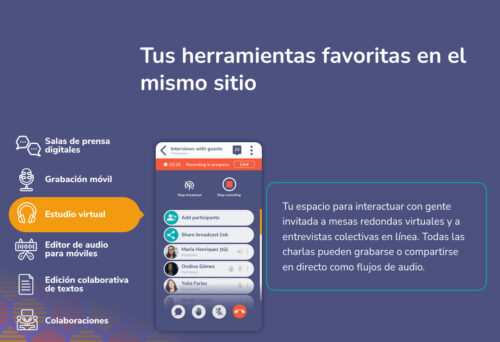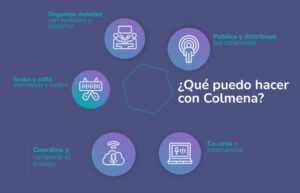Philip Bell. offset offset offset

offset offset offset#generativeart pic.twitter.com/YQKDILSM7p
— Philip Bell (@philipbell_) April 27, 2022


offset offset offset#generativeart pic.twitter.com/YQKDILSM7p
— Philip Bell (@philipbell_) April 27, 2022
The Fix launched Toolbox, a series on digital tools used by the media. The aim of Toolbox is to help managers pick the most appropriate tools for themselves, rather than throwing a bunch of “best newsroom tools” for this and that at them.

Colmena es tu caja de herramientas digital para producciones radiofónicas y contenidos locales y comunitarias.

Perhaps you have wondered how predictable machines like computers can generate randomness. In reality, most random numbers used in computer programs are pseudo-random, which means they are generated in a predictable fashion using a mathematical formula. This is fine for many purposes, but it may not be random in the way you expect if you’re used to dice rolls and lottery drawings.
RANDOM.ORG offers true random numbers to anyone on the Internet. The randomness comes from atmospheric noise, which for many purposes is better than the pseudo-random number algorithms typically used in computer programs. People use RANDOM.ORG for holding drawings, lotteries and sweepstakes, to drive online games, for scientific applications and for art and music.
Ser pobre, de nuevo, es una percepción por comparativa. Y esto tiene una trascendencia crucial a la hora de entender el actual panorama de polarización en el que vivimos: mientras que los de arriba intentan convencer al mundo de una visión cartesiana y cientificista de la realidad (que curiosamente coincide a pies juntillas con su experiencia vital), los de abajo se la explican a través de sus percepciones y experiencias del día a día. Y la pobreza, amigos, se adhiere a la piel hasta fundirse con ella. Y la percepción de injusticia aumenta con cada gesto, con cada pequeña discriminación sentida, hasta degenerar en rabia. Entender esta dicotomía de la percepción de la realidad es clave si queremos entender por qué los de abajo apoyan a las lepen, los bolsonaro, los castillo o a los abascales de turno. Reacciones contra un establishment que sigue hablando para sí mismo, mientras el resto del mundo se muere, casi literalmente, de hambre.
Okay, like virtually everyone else who studies social media, I'm fascinated by @elonmusk's takeover of Twitter. Let me say upfront: I have no idea what Twitter will be like under Elon's leadership and neither do you. But that's the point.
— Ethan Zuckerman (@EthanZ) April 25, 2022
Convert curl commands to Python, JavaScript, PHP, R, Go, Rust, Elixir, Java, MATLAB, Dart, CFML, Ansible URI, Strest or JSON
YOLOv4 installation has for a while been very tricky to install…until today. I will show you how to install YOLOv4 TensorFlow running on video in under 5 minutes.
You can run this either on CPU or CUDA Supported GPU (Nvidia Only). I achieved 3 FPS on CPU and 30 FPS on GPU (1080Ti)
Play all your games on Linux
Lutris is a video game preservation platform aiming to keep your video game collection up and running for the years to come.
Over the years, video games have gone through many different hardware and software platforms. By offering the best software available to run your games, Lutris makes it easy to run all your games, old and new.
FDD sirve para disfrutar de juegos de MSDOS desde tu distro GNU+Linux y poder ejecutar el que quieres jugar desde la línea de comandos. Surge de la necesidad de poder disfrutar en cualquier ordenador con GNU+Linux de juegos para MSDOS sin mucho trabajo.
Con utilizar el cliente es suficiente para jugar. Montarte ya el server es otra cosa.
Desde la década de los años veinte empieza a plantearse en España la posibilidad de incorporar la fotografía aérea a los trabajos catastrales, realizándose los primeros experimentos al respecto en los años treinta. Entre tanto, fue la iniciativa privada, representada por la Compañía Española de Trabajos Fotogramétricos Aéreos (CETFA), la que asumió el grueso de las labores fotogramétricas, trabajando de manera sucesiva para las Confederaciones Hidrográficas, la Diputación de Navarra, los Ayuntamientos, o incluso los propios servicios del Estado, el Instituto Geográfico Nacional y el Ministerio de Hacienda
A este fenómeno lo bautizaron los habitantes de los Alpes que contemplaban el brillo de las altas cumbres después de que el sol se hubiera escondido tras el horizonte. Por eso se conoce como ‘resplandor alpino’ o Alpenglow, que viene de la palabra alemana Alpenglühen.
Hoy en día el término Alpenglow no se utiliza solo para describir la última luz en la cima de las montañas: también vale para describir la luz que ilumina la parte más alta de un rascacielos, como en este atardecer en Nueva York.
Si seguimos hacia arriba y tomamos la definición de Alpenglow en este sentido tan amplio, cada vez que vemos pasar la Estación Espacial Internacional (ISS) sobre nuestras cabezas cruzando el cielo nocturno (hay aplicaciones que te dicen en qué días y horas se ve mejor), estamos viendo un objeto iluminado por el sol en las alturas que brilla en medio de la noche.
The autocomplete is generated with help from jQuery UI Autocomplete, a script that is included in WordPress as default.

Los nuevos datos del INE, relativos a 2018, revelan las brechas entre Norte y Sur del país y las desigualdades internas en las grandes ciudades
El “Atlas de la Vulnerabilidad Urbana” en España 2001-2011 es una aplicación web que ofrece información estadística y permite analizar la vulnerabilidad urbana a nivel de sección censal en todos los municipios de España, generando mapas temáticos de diferentes indicadores. Es una herramienta complementaria al “Visor del Catálogo de Barrios Vulnerables”, dentro de las varias que ofrece el “Observatorio de la Vulnerabilidad Urbana en España”. Se ha realizado a partir de los datos del INE (Instituto Nacional de Estadística) de los Censos de Población y Vivienda de 2001 y de 2011, y se actualizará próximamente cuando estén disponibles los nuevos datos correspondientes a 2021.
How to apply a filter
* Right-click on the layer listed in panel Layers
* Choose Filter...
* The window Query Builder is displayed
How to build a query in Query Builder
* Double click on a field in Fields list
* Select All in Values
* Choose a operator from Operators
* Double click on a value in Values list
* Your expression is shown at the bottom of the window
* Click Test to have a preview of how many rows are returned
* Click OK to apply the filter
* The layer is displayed according to the filter applied (you see a filter icon aside the layer name in panel Layers)
In this essay a new form of Internet activism is proposed: stacktivism. Building on hacktivist practices, this form of code and standard development as political struggle is envisioned to connect different layers of the techno-protological stack (also known as the Internet) in order build bridges between different, still isolated institutional levels and disciplinary practices such as grassroots wifi-access initiatives, interface design, geeks, computer scientists and governance experts. How do we envision a public stack that goes beyond the structures such ICANN, IETF and IGF that can take up the task to rebuild the Internet as a decentralized, federated, public infrastructure?
In Git, there are two main ways to integrate changes from one branch into another: the merge and the rebase.
gruvbox is heavily inspired by badwolf, jellybeans and solarized.
Designed as a bright theme with pastel ‘retro groove’ colors and light/dark mode switching in the way of solarized. The main focus when developing gruvbox is to keep colors easily distinguishable, contrast enough and still pleasant for the eyes.

Como explica en su entrada Daniskarma, el QGIS tiene un complemento llamado Spanish Inspire Catastral Downloader que le permite elegir una provincia y descargar automáticamente los datos, dibujando mapas que nos ayudan en el conocimiento de su análisis y diaganóstico antes de comenzar a intervenir en ellas.

El mapa estaba realizado con datos del catastro que llevan asociados el año de construcción o última reforma. Se presenta un radio de 2,5 km desde el centro de la ciudad. La estética resultante es la de unas vidrieras de estilo rosetón, gracias a su forma circular y su vibrante colorido.
There’s three steps to add zoom and pan behaviour to an element:
d3.zoom() to create a zoom behaviour functionQuantile and quantize scales have very similar names, confusingly so. Here’s how to remember their meanings:
Quantiles are defined, in statistics, as separating a population into intervals of similar sizes (the 10% poorest, the 50% tallest, the 1% richest…); a quantile scale is essentially defined by its domain, a fixed set of values — when applied to a new value, it will then compute its ranking with respect to the initial distribution, and map that ranking to the output range.
To Quantize means to group values with discrete increments — like expressing a list of floating point numbers with 1 decimal digit, or rounding time to the closest minute. It is the output range that is discretized, and such a scale allows to transform an initial continuous range into a discrete set of classes.
Threshold scales allow us to directly specify the cut values that separate the classes.
When, on a print map, 1 cm figures a real distance of 1 km on the terrain, we say that the map has a 1:100,000 scale.
But scales are not limited to a proportional ratio (or rule of three) between an actual distance and a length on paper. More generally, they describe how an actual dimension of the original data is to be represented as a visual variable. In this sense, scales are one of the most fundamental abstractions of data visualization.
Scales from the d3-scale module are functions that take as input the actual value of a measurement or property. Their output can in turn be used to encode a relevant representation.
Los más de 400 alumnos y profesores del centro, el CEIP Isaac de Vega del municipio de Granadilla, fueron trasladados a otro colegio mientras se inspeccionaba el centro
A series of examples for using d3.js utility functions minimally in p5.js without inter-mingling their different paradigms.
¿Qué es la economía del comportamiento?
[Karlos] Hay varios autores, especialmente Thaler y alguno que comparte con él sus teorías, que lo que vienen a decir es que, dada esa racionalidad delimitada, lo que tenemos es un gap. Queremos (en un discurso muy tiktokero) ser «la mejor versión de ti mismo» y estamos muy forzados a querer ser esa mejor versión. Pero claro, resulta que yo no era tan racional como me habían dicho, como ese «homo economicus» me había dicho. Ahí es donde estos autores dicen, podemos utilizar esos heurísticos, esos sesgos, para ayudar, mediante un concepto que utilizan: el paternalismo libertario. Tu siempre vas a tener la libertad de decir que no, pero yo voy a poder empujar (de ahí el libro famoso de Nudge, de Thaler) para, mediante ese pequeño empujón, poder hacer eso que tu irracionalidad no te permite.
This sketch uses the p5.Vector class to create an animation of snow that accumulates on the ground.
Tiled is a free and open source, easy to use, and flexible level editor.
Generated Space is the result of a year-long endeavour to make computers do unexpected things.
It presents a wide range of different generative algorithms; from organic flow fields and particle systems to rigid fractals and grammar-based shapes. Some more serious than others.
All the code is open source and available on GitHub, so feel free to change and improve upon any sketches that interests you.
MapCSS is a specification of style language explicitly designed to describe the look of the OpenStreetMap data
…Olson is a lynchpin of YouTube’s burgeoning video essay genre, creating longform lecture performances on the intersection of pop culture and philosophy. No material is beneath his contemplation, which is thorough, to say the least: Like an enthusiastic professor, Olson deconstructs anything, from 50 Shades of Grey and Detective Pikachu to the conspiracies of flat-Earth truthers, with charitable nerdiness, electrified by sincerity. Over the past six years, he’s steadily grown his audience to some 640,000 subscribers.
Alphabet [YouTube and Google’s parent company] is absolutely doing what they can to undermine social services and civil infrastructure, but they’re not trying to destabilize the very mechanism by which individuals interact with the economy.
My ideal environment from which to do my stuff is a fantasy. It couldn’t exist in reality. I can’t say: I want a healthy network effect, I want good moderation tools, I want it to be frictionless for my viewers, and I also want it to keep up with changes in technology, and I don’t want to have to spend hundreds of hours implementing that myself. I want to be able to focus on my stuff, which is writing; which is making videos I don’t want to worry about hosting, and I want it all to be free of Big Tech, and I want it to be free of the decision making of some nebulous assholes.
I think there’s possibilities for the existence of a decorporatized version of the internet. It’s not going to come out of cryptocurrency, because that space is built off of financial incentives. The crypto space has a dire lack of imagination.
He tenido una idea de negocio: los OGTs. Vienen a responder a una necesidad REAL de la sociedad. ¿Cuántas veces te has planteado comprar un NFT y no lo has hecho porque era demasiado caro o porque era demasiado barato? Aquí entra el OGT.